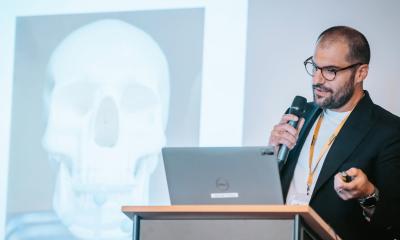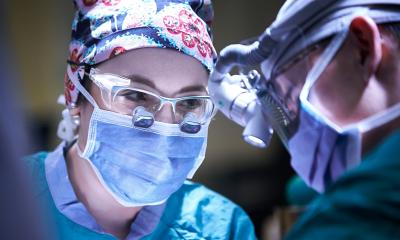Anaesthetist advises expansion of postoperative high-dependency services
A leading UK anaesthetist has said many hospitals could significantly reduce risks to patients undergoing surgery by expanding and developing their post-operative high-dependency services.

Dr John Carlisle explained there are a number of indicators that can identify and quantify risks to patients facing an operation, and steps that can be taken to reduce post-operative mortality. That includes managing patient expectation, fully informing a patient as to those risks – with the patient even opting not to undergo the surgery – and striking a balance between ‘hazardous cure and less hazardous partial cure.’
However, Dr Carlisle, who is consultant in preoperative preparation, anaesthesia and critical care at Torbay Hospital in S-W England, said: ‘Probably more important is postoperative monitoring and care, partly because this phase lasts much longer than surgery and is associated with greater physiological demands. To anaesthesiology and emergency care. ‘This award,’ said Dr Andrew Hartle, the association’s Honorary Secretary, ’is one of the AAGBI’s highest honours and recognises David Zideman’s substantial contributions to anaesthesia, emergency care, resuscitation and the success of the London 2012 Olympic and Paralympic Games. He deliver this safely, we need to expand the provision of postoperative highdependency services and for many hospitals this might mean trebling or quadrupling their current HDU beds.’
The subject of ‘How to identify a high risk patient and quantify their risk’ is on the agenda at the annual congress of the Association of Anaesthetists of Great Britain and Ireland in a presentation by Dr Carlisle. ‘Anaesthetists have an ethical duty to quantify harm and benefit to patients to help those undergoing surgery make better informed decisions about the procedure they may be having,’ he said. ‘Failing to do so risks people making decisions based upon false assumptions. We also have a clinical or organisational duty to quantify these risks, because the safe perioperative care of patients depends upon us recognising how has played and continues to play an important part in UK medicine and is a worthy recipient of this honour.’
As the Clinical Lead for the Emergency Medical Services, Dr Zideman was part of a team that recruited more than 4,000 medical volunteers (2,000 in the emergency medical teams) from all parts of the health service. ‘I planned an emergency medical service that included the recruitment of volunteers, the selection and provision of equipment, and undertook the training of all our volunteer staff,’ he explained. One significant need was to match the professional skills of his team members carefully to each individual sport, to ensure an effective and efficient service, for example, in the boxing arena compared with swimming at the Aquatics Centre. ‘It was,’ he added, ‘all about having the best possible system for optimising pre-hospital care for anyone in an Olympic or Paralympic venue who became seriously ill or was injured.’
Comprehensive training system for volunteers was an essential element, he said.‘The very simple message is that our system worked thanks to our trained volunteers. Each volunteer received around 18-20 hours training in total. This included teams arriving before their shifts and practicing various scenarios thereby familiarising themselves with the venue and much hazard each patient faces and distributing scarce resources – such as intensive care and Monday morning lists – appropriately.’ When it comes to surgery, Dr Carlisle said patients who are older, male, less mobile, under-weight or already have a life-threatening disease are most at risk of dying, along with those undergoing emergency surgery because they are acutely unwell and more likely to undergo surgery outside normal working hours. ‘Most people having scheduled surgery don’t die or become infirm because of the surgery, but substantial proportions can be unhappy with the results,’ he pointed out. ‘Therefore an important part of patient preparation is the assessment of their expectations and if necessary realigning them with reality. This process can pieces of equipment they might not be familiar with. Most importantly it ensured that they got used to working as a team with other volunteers who might change on a daily basis.’
During the Games Dr Zideman visited up to four venues per day, and participated and provided clinical support and advice to his volunteer teams. ‘It was a great pleasure providing the structure for our tremendous emergency medical volunteer teams,’ he said. ‘I’m delighted to report that across the entire Olympic and Paralympic games, we did not have to perform a single general anaesthetic or emergency tracheal intubation.’ He hopes that the lessons learnt from London 2012 will be carried forward to the Olympics in Sochi and Rio. contribute indirectly to a reduction in postoperative mortality and morbidity, because about a quarter of patients fully-informed of postoperative outcomes decide to decline surgical treatment.’ Anaesthetists can quantify that risk for mortality by factoring in the average mortality risk for a person of a given age and sex, and adjusting it for all known factors that independently affect this risk.
However, to simplify the process Dr Carlisle has developed a calculator that can work out the risk at https://sites.google. com/site/informrisk
An anaesthetist also needs to ensure his colleagues are ‘in the loop’ as the role of other clinicians around the anaesthetist, and effective communication with them, is crucial in reducing that risk. In helping reduce the risk of surgery, anaesthetists should look to strike a balance between hazardous cure and less hazardous partialcure or palliation. ‘The risk of dying will often be higher for a year-or-so after hazardous curative treatment, for instance complete resection of a colorectal tumour, compared to, say, stenting of a colorectal cancer that threatens bowel obstruction,’ he said and added that the safety of perioperative care increases through ensuring that ‘the right patient has the right operation at the right time, delivered by the right team’ and that the relevant equipment, such as intraoperative cardiac output monitoring is in place. Patient risk can be further reduced by ensuring their fitness for surgery, they are taking the prescribed drugs and are of sufficient weight to undergo a urgical procedure. Key learning points: Understanding and communicating risk is important; risk quantification is an ethical and practical imperative, and anaesthetists should not only estimate mortality risk but other outcomes of postoperative damage and patient dissatisfaction.
PROFILE
Dr John Carlisle is consultant in preoperative preparation, anaesthesia and critical care at Torbay Hospital, South Devon NHS Foundation Trust. His main areas of interest are perioperative risk compared to ‘at home’ risk; cardiopulmonary exercise testing; evidence-based medicine including systematic reviews; detection of data fabrication. He is editor & author for the Cochrane collaboration, editor for the journal Anaesthesia, author for Oxford Handbooks of: anaesthesia; day surgery; vascular surgery and an instructor on the biannual CPET workshop course. At the Association of Anaesthetists of Great Britain and Ireland annual congress, this September, he presented the session How to identify a high-risk patient and quantify their risk.
05.11.2012











